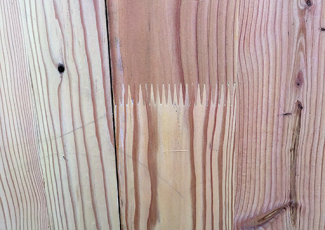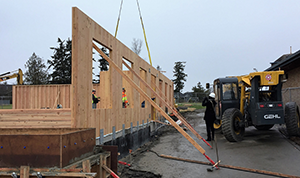Cross-laminated timber pilot project
The Department of Enterprise Services oversaw a pilot project to build 20 kindergarten through third-grade classrooms using cross-laminated timber (CLT) in five school district sites in Washington.
Using cross-laminated timber panels in construction is highly advantageous as it offers both design flexibility and lower environmental impacts.

CLT is a prefabricated, solid engineered wood panel. Structural openings such as doors and windows are incorporated within the large modular panels at the manufacturing plant. The panels provide both structural stability and lateral stiffness, and have a fire resistance that is comparable to steel and concrete. Wood also stores and sequesters carbon, keeping it out of the atmosphere, and is a renewable natural resource.
CLT is manufactured in the Northwest using trees that in the past have not been economical to harvest, including small Douglas fir, Western hemlock and other trees that have diameters as small as 4 inches -- including some dead or diseased trees. Forests in the state are filled with such trees, which can fuel wildfires and pest outbreaks.

The state's 2016 supplemental capital budget included $5.5 million in the state building construction account for the pilot project in 2017, which in addition to constructing the classrooms will measure how well using the engineered wood product creates efficiencies in the construction process, and achieves other environmental and economic benefits. Potential benefits include:
- Reduced quantity of construction site waste due to prefabrication of panels.
- Quicker construction time because services can be installed and finishes applied while panel installation continues.
- Creation of local jobs, especially in rural communities.
- Making it profitable to thin forests, thus reducing the danger of wildfires.
- Reduced use of fossil fuels to manufacture using wood, compared to using structural concrete, masonry or steel.
Four modular classrooms were built in each of the following school districts:
Western Washington
- Seattle School District – Maple Elementary
- Mount Vernon School District - Jefferson Elementary
- Sequim School District - Greywolf Elementary
Eastern Washington
- Wapato School District – Adams Elementary
- Toppenish School District – Valley View Elementary